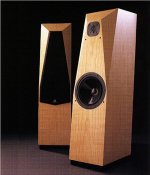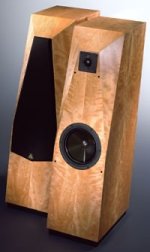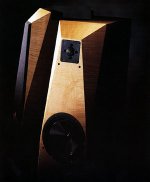There are a lot of recommendations to keep the distance between speaker drive units as close to each other as possible, especially the drivers for higher frequency, because a point source configuration is preferred.
Let’s look at these “Avalon” speakers. They are two ways system comprising a woofer and a tweeter per cabinet. But, as can be seen, those two drivers are positioned so far from each other, and work together (crossover point) at high frequency as a typical two-way system. So, does the distance between drivers really matter?
Or, in fact, the statement above is true, but Avalon has applied the special techniques on them. Is there anyone used to reversed engineering these speakers? Could you please advise us what are the magic/secret designs—the special approaches/techniques, e.g., using higher-order crossovers with large overlap, or using lower-order with a lot of EQ circuits including baffle step correction, etc.?



Let’s look at these “Avalon” speakers. They are two ways system comprising a woofer and a tweeter per cabinet. But, as can be seen, those two drivers are positioned so far from each other, and work together (crossover point) at high frequency as a typical two-way system. So, does the distance between drivers really matter?
Or, in fact, the statement above is true, but Avalon has applied the special techniques on them. Is there anyone used to reversed engineering these speakers? Could you please advise us what are the magic/secret designs—the special approaches/techniques, e.g., using higher-order crossovers with large overlap, or using lower-order with a lot of EQ circuits including baffle step correction, etc.?



If you’re planning to replicate or understand Avalon design,Measure their acoustic and electrical responses. Simulate their behavior in tools like VituixCAD or SoundEasy. Consider wavefront shaping and diffraction control, not just raw SPL curves.There are a lot of recommendations to keep the distance between speaker drive units as close to each other as possible, especially the drivers for higher frequency, because a point source configuration is preferred.
Let’s look at these “Avalon” speakers. They are two ways system comprising a woofer and a tweeter per cabinet. But, as can be seen, those two drivers are positioned so far from each other, and work together (crossover point) at high frequency as a typical two-way system. So, does the distance between drivers really matter?
Or, in fact, the statement above is true, but Avalon has applied the special techniques on them. Is there anyone used to reversed engineering these speakers? Could you please advise us what are the magic/secret designs—the special approaches/techniques, e.g., using higher-order crossovers with large overlap, or using lower-order with a lot of EQ circuits including baffle step correction, etc.?
View attachment 1471975
View attachment 1471976
View attachment 1471977
That speaker appears to be crossed at 1k and should be 13.5 inches center to center distance for the drivers.
Crossover slopes aren’t specified and would allow this to change by slope. It appears it was a design trade off in addition to the baffle machining appears to be the same position relative to where the midrange would go.

Crossover slopes aren’t specified and would allow this to change by slope. It appears it was a design trade off in addition to the baffle machining appears to be the same position relative to where the midrange would go.
Hifijim tested and build speakers that proved that the CTC distance is an overall design choice - with each of its compromises and advantages:
https://www.diyaudio.com/community/threads/how-do-you-personally-set-mid-tweeter-ctc-spacing.426683/
But the longer distance definitely looks weird sometimes 🫣
https://www.diyaudio.com/community/threads/how-do-you-personally-set-mid-tweeter-ctc-spacing.426683/
But the longer distance definitely looks weird sometimes 🫣
CtC might not matter much if You have a static listening position and the drivers' delays are compensated..
For MTM or the like, the crossover and the CtC can be matched https://www.linkwitzlab.com/Horbach-Keele Presentation Part 2 V4.pdf
For MTM or the like, the crossover and the CtC can be matched https://www.linkwitzlab.com/Horbach-Keele Presentation Part 2 V4.pdf
- Home
- Loudspeakers
- Multi-Way
- Does distance between drivers really matter?